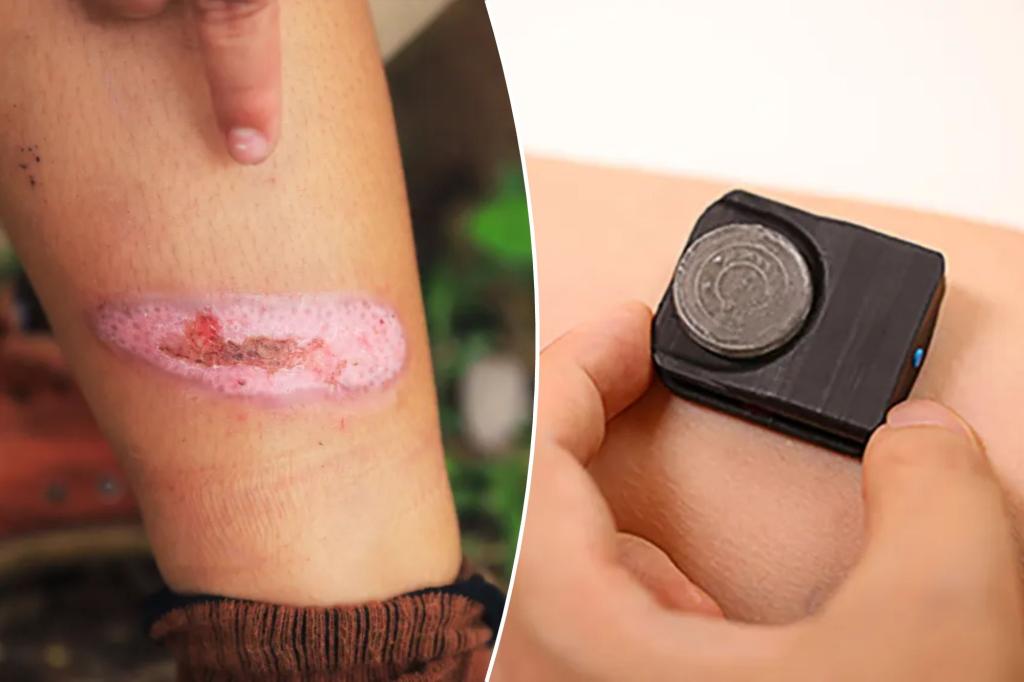Your skin isn’t just glowing — it’s gassy. And now, science is sniffing it out.
Researchers at Northwestern University have developed the world’s first contactless wearable device that can monitor your health by measuring gases naturally emitted and absorbed by the skin without ever touching it.
“This technology has the potential to transform clinical care, particularly for vulnerable populations, including newborn babies, the elderly, patients with diabetes, and others with compromised skin,” said Dr. Guillermo A. Ameer, a professor of biomedical engineering who co-led the study.
Secret signals
Your skin isn’t just a barrier; it’s a two-way street between your body and the outside world.
Every day, gases like carbon dioxide, water vapor, oxygen, and volatile organic compounds (VOCs) move in and out through the skin, which also protects you from irritants, toxins and allergens in the environment.
The device developed by Northwestern researchers can monitor all that activity without even laying a finger on you, opening up a new window into skin health.
Small but mighty
The gadget is tiny — just two centimeters long and one-and-a-half wide — and loaded with sensors that pull in gas samples through a mini air chamber that hovers just above the skin without making contact.
That’s a game-changer, since most wearable devices need to stick directly to the skin, which can be a challenge for people with fragile or damaged tissue.
The data it gathers can provide insights into everything from wound healing and hydration levels to early signs of infection and even exposure to toxic chemicals.
“For workers in potentially hazardous environments, it’s helpful to know how much of those hazardous species are entering the body through the skin,” said Dr. John Rogers, a professor and researcher at Northwestern who co-led the study.
Real-time monitoring at your fingertips
One of the biggest perks of the compact wearable is that it would allow patients to manage their skin health at home, eliminating the need for bulky, traditional hospital equipment.
Even better, it syncs with your smartphone or tablet to provide real-time data on the gases your skin is emitting and absorbing.
Researchers said this fast, accessible information can help healthcare providers make quicker, more informed treatment decisions, which is especially crucial for wound healing.
“Prescribing antibiotics for wounds can be a bit of a gamble,” said Ameer. “Sometimes it’s hard to tell if a wound is infected or not. By the time it’s obvious, it might be too late, and the patient can develop sepsis, which is incredibly dangerous.”
Increased water vapor, CO2, and VOCs are linked to bacterial growth and slower healing, so researchers said monitoring these factors could help caregivers detect infections earlier and more accurately, enabling faster intervention and better health outcomes.
“Being able to closely, continuously monitor a wound and prescribe an antibiotic at the earliest sign of infection is an obvious and important interest,” Ameer said.
Next steps
The Northwestern team envisions the device being used to enhance the effectiveness of bug repellents, skin care products and medications designed to improve skin health.
For example, CO2 and VOCs attract mosquitoes and other pests. By measuring these emissions from the skin, it could help scientists develop better strategies to keep them away.
The device could also help dermatologists measure how quickly lotions and creams penetrate the skin, while assisting researchers in evaluating the safety of cosmetics and personal care products.
Looking ahead, researchers want to refine the device’s capabilities, including adding a sensor to monitor changes in pH levels and creating gas sensors with more chemical selectivity for early detection of organ dysfunction and other diseases.
“This technology is not just about measuring gases and corresponding characteristics of the skin,” Rogers said.
“It’s about predicting overall health, preventing infection and disease, and creating a future where personalized care is driven by real-time, non-invasive continuous health tracking,” he continued.


